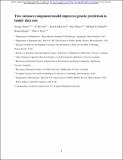| dc.contributor.author | Tucker, George Jay | |
| dc.contributor.author | Loh, Po-Ru | |
| dc.contributor.author | MacLeod, Iona M. | |
| dc.contributor.author | Hayes, Ben J. | |
| dc.contributor.author | Goddard, Michael E. | |
| dc.contributor.author | Berger Leighton, Bonnie | |
| dc.contributor.author | Price, Alkes L. | |
| dc.date.accessioned | 2020-08-14T23:19:56Z | |
| dc.date.available | 2020-08-14T23:19:56Z | |
| dc.date.issued | 2015-11 | |
| dc.date.submitted | 2015-03 | |
| dc.identifier.issn | 0002-9297 | |
| dc.identifier.uri | https://hdl.handle.net/1721.1/126606 | |
| dc.description.abstract | Genetic prediction based on either identity by state (IBS) sharing or pedigree information has been investigated extensively with best linear unbiased prediction (BLUP) methods. Such methods were pioneered in plant and animal-breeding literature and have since been applied to predict human traits, with the aim of eventual clinical utility. However, methods to combine IBS sharing and pedigree information for genetic prediction in humans have not been explored. We introduce a two-variance-component model for genetic prediction: one component for IBS sharing and one for approximate pedigree structure, both estimated with genetic markers. In simulations using real genotypes from the Candidate-gene Association Resource (CARe) and Framingham Heart Study (FHS) family cohorts,. we demonstrate that the two-variance-component model achieves gains in prediction r(2) over standard BLUP at current sample sizes, and we project, based on simulations, that these gains will continue to hold at larger sample sizes. Accordingly, in analyses of four quantitative phenotypes from CARe and two quantitative phenotypes from FHS, the two-variance-component model significantly improves prediction r(2) in each case, with up to a 20% relative improvement. We also find that standard mixed-model association tests can produce inflated test statistics in datasets with related individuals, whereas the two-variance-component model corrects for inflation. | en_US |
| dc.description.sponsorship | NIH (Grants R01 HG006399, R01 GM105857 and RO1 GM108348) | en_US |
| dc.description.sponsorship | NIH (Award F32 HG007805) | en_US |
| dc.language.iso | en | |
| dc.publisher | Elsevier BV | en_US |
| dc.relation.isversionof | http://dx.doi.org/10.1016/j.ajhg.2015.10.002 | en_US |
| dc.rights | Creative Commons Attribution-NonCommercial-NoDerivs License | en_US |
| dc.rights.uri | http://creativecommons.org/licenses/by-nc-nd/4.0/ | en_US |
| dc.source | Other repository | en_US |
| dc.title | Two-Variance-Component Model Improves Genetic Prediction in Family Datasets | en_US |
| dc.type | Article | en_US |
| dc.identifier.citation | Tucker, George et al. "Two-Variance-Component Model Improves Genetic Prediction in Family Datasets." American Journal of Human Genetics 97, 5 (November 2015): P677-690 © 2015 The American Society of Human Genetics | en_US |
| dc.contributor.department | Massachusetts Institute of Technology. Department of Mathematics | en_US |
| dc.relation.journal | American Journal of Human Genetics | en_US |
| dc.eprint.version | Original manuscript | en_US |
| dc.type.uri | http://purl.org/eprint/type/JournalArticle | en_US |
| eprint.status | http://purl.org/eprint/status/NonPeerReviewed | en_US |
| dc.date.updated | 2019-09-23T10:51:26Z | |
| dspace.date.submission | 2019-09-23T10:51:28Z | |
| mit.journal.volume | 97 | en_US |
| mit.journal.issue | 5 | en_US |
| mit.metadata.status | Complete | |
